Group 1 teams funded by the MoD
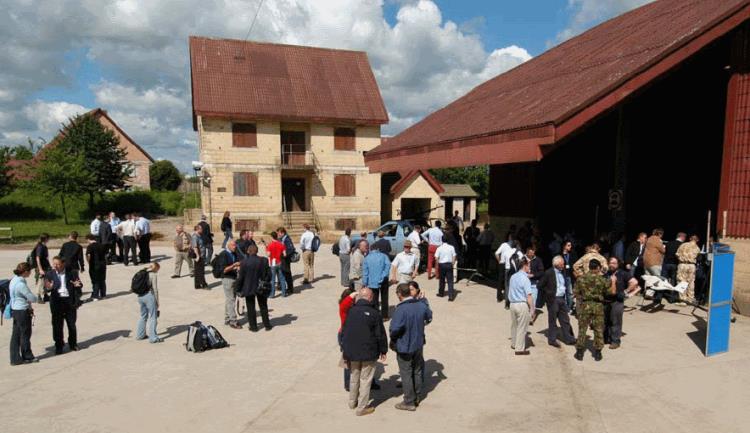
photograph by Cpl Russ Nolan RLC, British Army
Barnard Microsystems Team
- Barnard Microsystems
- OptoSignal Limited
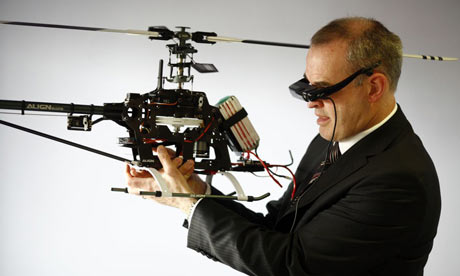
An unmanned aerial still camera helicopter, held by Joseph Barnard. Photograph: Martin Argles from www.guardian.co.uk
They are offering a system based on the use of Unmanned Helicopters and aircraft. More information on the work performed is to be found on this web site.
Barnard Microsystems, for example, plans to adapt an Unmanned Aerial Vehicle it has designed to survey oil pipelines in remote areas. - from http://news.bbc.co.uk/1/hi/technology/6919271.stm
MIRA Team
- MIRA Limited
- ERA Technologies Limited
- BAE Systems ATC
- GFS Projects Limited
- University of Warwick
- Royal Grammar Guildford School 6th Form
They are offering a land based platform carrying mainly optical sensors with a tethered aerial camera for situational awareness.
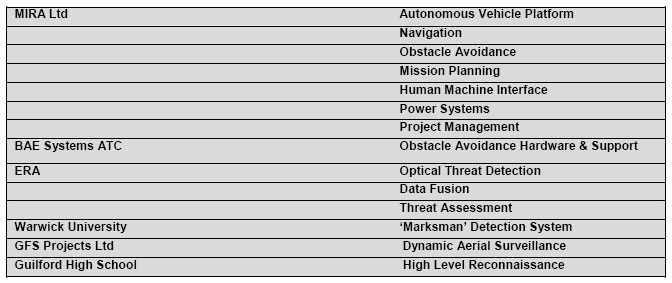
from www.mira.co.uk/media/
GFS enters new flying-saucer UAV in UK MoD's Grand Challenge
By Rob Coppinger, DATE: 8 February 2008, SOURCE: Flight International
GFS Projects is to participate in the UK Ministry of Defence's Grand Challenge competition in August using a new 800 mm diameter Coanda-effect vertical take-off and landing unmanned air vehicle that will co-operate with a robotic ground vehicle.
The UAV will have a carbonfibre structure provided by the UK composites specialist Lola Group , a two-stroke engine running on an oil/petrol mix and a maximum take-off weight of 18.5 kg. Payload capacity is 4 kg and maximum fuel load 2.5 kg. Test flights are expected at the end of April.
"We are working with [product engineering specialist] MIRA on the MoD's Grand Challenge and we are talking to a raft of people about investment. We have completed the first contract with the [US military]," says GFS founder Geoff Hatton. MIRA will provide the robotic ground vehicle for the challenge and Hatton is meeting with the US military to discuss a possible follow-on contract.
Air blown over the curved surface of the saucer-shaped vehicle generates lift as a result of the Coanda effect . Gust response is still an issue, Hatton says, and its resolution is linked closely to the vehicle's mass. The heavier the UAV, the more effective its gust resistance.
Silicon Valley Team
- Silicon ValleySystems Limited
- IDUS Consultancy
- Moonbuggy Limited
- Kingston University
- Reading University
- Bruton School for Girls
They are offering a combination of fixed, ground and air platforms with optical, laser range finder and acoustic sensors.
A third team, Silicon Valley , has opted to rely less heavily on autonomous vehicles. They have used off-the-shelf technology for the hardware as much as possible, and focused more development onto image recognition and analysis software.
"If you can automate that part, then you have a useful tool," explains team leader, Norman Gregory. "What we intend to do is deploy various platforms, depending on what the scenario is."
The team will use a mixture of ground and air-based vehicles, although the team is not yet releasing the exact details. The main ground vehicle is the size of a ride-on lawnmower and can be GPS-guided or remotely directed by a human.
Stellar Team
- Stellar Services Limited
- Blue Bear Systems Limited
- Cranfield University
- SELEX Sensors and Airborne Systems Limited
- TRW Conekt
- Marshall Specialist Vehicles
They are offering SATURN: an integrated system with a high level and a micro-Unmanned Air Vehicle, an Unmanned Ground Vehicle and a control station, fusing data from visual, thermal and radar sensors.
"The platforms have got autonomous threat detection sensors on them based on visual, thermal and radar," explained Dr Julia Richardson, head of the Team.
Others, such as Team Stellar has proposed a multiple vehicle approach. Its Saturn (Sensing and Autonomous Tactical Reconnaissance Network) proposal consists of two different UAVs and an unmanned ground vehicle (UGV).
from http://news.bbc.co.uk/1/hi/technology/6919271.stm
Cranfield’s input to ‘Team Stellar’ will involve the Applied Mathematics and Computing Group focusing on creating computer based software for automatic target recognition. The Guidance and Control Group at Cranfield University, Shrivenham, will be working to co-ordinate vehicle guidance and execution.
Blue Bear Systems Research Limited are designing both UAV systems and their associated control and avionics systems, and Selex Sensors and Airborne Systems are involved with overall system integration and development of the project’s ground control station.
Stellar Research Services will be leading project management, while Marshall SV will provide the UGV, and TRW Conekt will be providing headway, obstacle and threat sensors for the UGV.
from www.cranfield.ac.uk
TRW Conekt will be providing specialist headway, obstacle and threat sensors for the UGV (provided by Marshalls Specialist Vehicles), combining its skills from the Automotive, Defence & Aerospace Industries.
from http://www.conekt.net/consulting-services/collaborative-rad-projects
Swarm Systems Team
- Swarm Systems Limited
- Park Technical Services
- Orrcam Limited
- The University of Essex
- The University of Surrey
They are offering Owl: a lightweight, quadrotor, Unmanned Air Vehicle with three, high-resolution, still colour cameras.
Its proposal consists of eight to 10 "dinner-plate sized" quad-rotor helicopters which would be able to fly in and out of buildings. "There is only so much information you can capture from one vehicle," Stephen Crampton, the head of the Team, told the BBC News website. Equipped with high-resolution cameras, the swarm will use numbers to its advantage. "You can get images from different points of view, which is often very important because something you can see from one angle, you can't from another," said Dr Owen Holland, another member of the Team.
from http://news.bbc.co.uk/1/hi/technology/6919271.stm
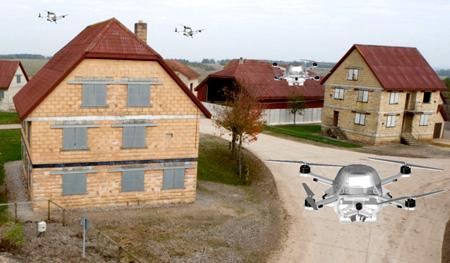
from www.newscientist.com
Owl swarm
A team called Swarm Systems uses more robots. "We need to gather as much sensory information as possible," says team leader Stephen Crampton, "so we're using eight vehicles. And we're going by air because it gives you more viewing angles."
Dubbed "Owls", their battery-powered, Frisbee-sized vehicles weigh under a kilogram and have four small propellers (see image, right). Able to hover and dart like birds, they are GPS-guided and communicate with one another, and the base station, using Wi-Fi. Each Owl carries a trio of 5 megapixel cameras.
"Without giving too much away, the processing power on board each of these vehicles is pretty impressive," adds Crampton. "They could run full-blown Windows Vista."
Team Tumbleweed
- The University of Manchester
- AV-i Limited
- BAE Systems
- MBDA
They are offering a small UAV with stabilised electro-optical sensor system. "Flying ball uses feature-tracking software to identify threats." from www.guardian.co.uk
Group 2 teams not funded by the MoD
Cortex Team
- Qinetiq
They are offering Tiger: a multiple platform UAV concept that uses an array of multi-spectral sensors and target recognition techniques.
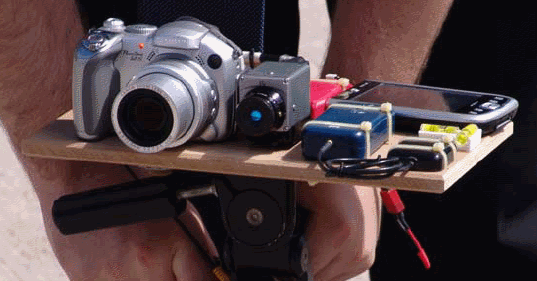
Above: glimpse of the possible basis of the Qinetiq system, seen at the kick-off meeting at Copehill Down.
MicroPilot Teams up with QinetiQ In the UK MOD Grand Challenge
October 9, 2008
The UK MOD Grand Challenge, as part of the Defence Technology Strategy, is a science and technology competition providing an opening into the UK defence market for new suppliers and investors. The challenge is to create a system with a high degree of autonomy that can detect, identify, locate and report a comprehensive range of military threats in an urban environment. Team Cortex from QinetiQ successfully integrated MicroPilot’s MP2128 HELI autopilot into the Tiger VTOL; a multiple platform UAV concept that uses an array of multispectral sensors and target recognition techniques.
Team Cortex was awarded the Judges Merit for the most innovative platform technology that shows a clear military benefit. Jon Stoackley of QinetiQ stated, “the Tiger VTOL generated a huge amount of interest from all levels of UK Military.”
With 500 clients in 60 countries, MicroPilot is world leader in miniature autopilots for UAV’s and MAV’s. Weighing 28 grams MicroPilot offers a full line of UAV autopilots, accessories, customization, HORIZON ground control software and training at our 40 acre flight facility. Our low cost MP2128 HELI flies helicopters, VTOL and fixed wing. For triple redundancy, MP2128 HELI3x for helicopters and MP2028 3x for fixed wing. Just released MP-trueHWIL Matlab-based hardware in the loop electrically simulates all sensors, providing the highest fidelity autopilot simulation available. Newest product is SimView Mission Training Software. This feature allows you to conduct Ab Initio training for payload operators.
Congratulations Team Cortex who plan on entering the Grand Challenge 2 with a new and improved Tiger VTOL equipped with MicroPilot’s MP2128 HELI autopilot.
from http://www.micropilot.com/news-2008-oct-9.htm
Dragonfly Air Systems Team - WITHDRAWN
- Dragonfly Air Systems
- Gress Aerospace (Canada)
- Controp Precision Technologies Limited (Israel)
- Birmingham University
They are offering a lightweight UAV with sensor package.
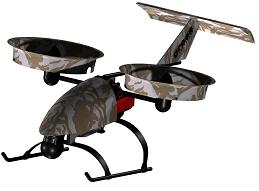
The above image is from the Dragonfly Air Systems web site at http://www.dragonflyairsystems.com/, showing a two bladed, lightweight, helicopter.
Mindsheet Team
- Mindsheet Limited
Offering their Testudo: an Unmanned Ground Vehicle with an air surveillance platform and tethered blimp relay station.
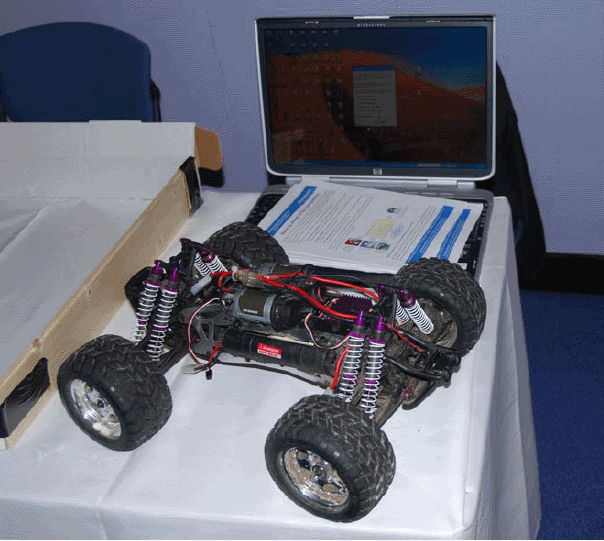
Rapid Systems Solutions Team - Merged with Team Tumbleweed
- Rapid Systems Solutions Limited
- Manchester University
- Oxford Brookes University
- The Northwest Composites Centre
They are offering a four wheeled ground robot incorporating a supporting tethered air vehicle.
"RSS are in consultation with sensor and communications partners and aim to develop a winning solution. The air system development vehicle has been designed and manufactured with a lead time of 2 weeks. The development is on time, on target, and on budget". - from http://www.rapid-systems-solutions.com/new_page_4.htm
Sagentia Team - WITHDRAWN
- Sagentia Limited
Two small, stabilised, helicopters with a combination of infra-red and visible spectrum sensors.
Team i-Spy
- Middlesex University
A combined short range and medium range UAV system to deliver optical and thermal sensing.
A TECHNOLOGY whiz kid from Camden Town could change the face of warfare if his ideas are adopted by the armed forces. Tom Foran is entering the MoD's Grand Challenge to find new ways of detecting threats to its troops. The 20-year-old and his team of fellow students from Middlesex University are designing a UAV (unmanned autonomous vehicle) that will fly above the ground spotting snipers, bombs and enemy vehicles. The hi-tech spy plane will be mounted with thermal imaging equipment and robotic cameras and will relay information back to base without the need for a pilot. The York Way resident said: "Other teams entering the challenge are designing ground-based UAVs. But we are developing a flying vehicle as the air is probably the safest place to be in a battlefield. "Being airborne will also give the best viewing angles and provide the most detailed information."
The five-man team, including lecturer Dr Stephen Prior and a PhD student, expect the project to cost more than £30,000. Dr Prior said: "We are now seeking partners to help fund the development of this exciting work."
from http://www.hamhigh.co.uk/, article by by Ed Thomas
Team Locust
- Advanced New Technologies
- Scientific Limited
- Portsmouth University
They are offering multiple sensors carried by small UAVs to create a sensor array of the target area.
The Thales Team (T3)
- Thales
- The University of Reading
- Cranfield University
- Exeter University
- The University of Loughborough
Thales are also looking to engage a whole network of Schools, bringing the excitement of this technical challenge to the next generation of scientists and engineers.
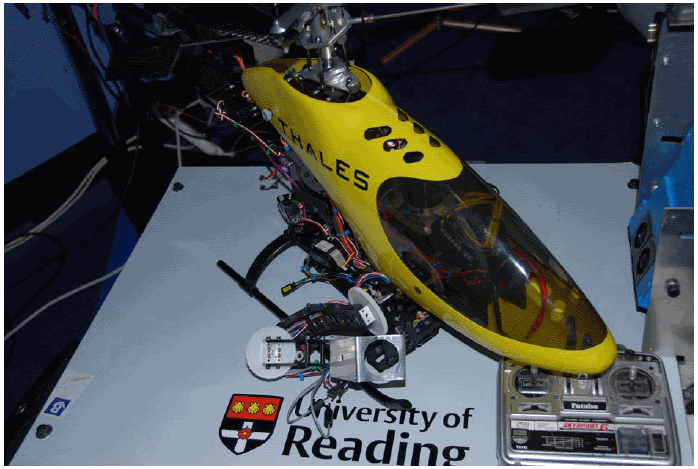
Photograph taken at the Grand Challenge All Teams Briefing on the 30th April 2008.